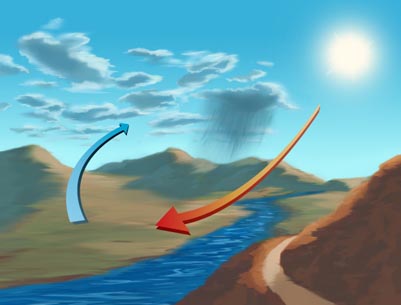|

DESCRIBE WAYS THE ATMOSPHERE IMPACTS THE CLIMATE AND WEATHER.AtmosphereLet's consider the atmosphere first. You probably do not notice, but the air around you, or the atmosphere, has weight that is always pushing on you. The atmospheric pressure, or air pressure, is heavier near the earth's surface than it is higher up in the atmosphere. This means that lower altitudes, or areas that are close to sea level, have more air pushing down on them than do higher altitudes, such as mountains. The air gets less and less dense the higher you go. The air pressure in the upper portion of the atmosphere is so thin that there is not enough air for humans to breathe. This is why high-flying aircraft must be sealed and pressurized.
Altitude is not the only thing that affects air pressure; heat also affects air pressure. When the sun heats the air, the air becomes less dense, which means it is not so heavy and it begins to rise. Have you ever seen a hot air balloon? They are a frequent sight near my home. The balloonists take off early in the morning while the air temperature near the ground is still very cool. Using a burner and a fan, they fill their balloons with hot air. After the balloon is full, the balloonist uses the burner to keep the balloon's air warm. The warm air rises, and the rising air lifts the balloon. When the balloonist is ready to land, the air is allowed to cool. As the air cools, it becomes denser and the balloon settles towards the ground.
When the sun warms the air, the air begins to rise, just as it does in the hot air balloon. However, since there is no burner keeping the air warm, it begins to cool as it rises. If the air carries enough water vapor, the cooler temperatures will cause the water to condense and form clouds.  
|
About Us | Terms of Use | Contact Us | Partner with Us | Press Release | Sitemap | Disclaimer | Privacy Policy
©1999-2011 OpenLearningWorld . com - All Rights Reserved



